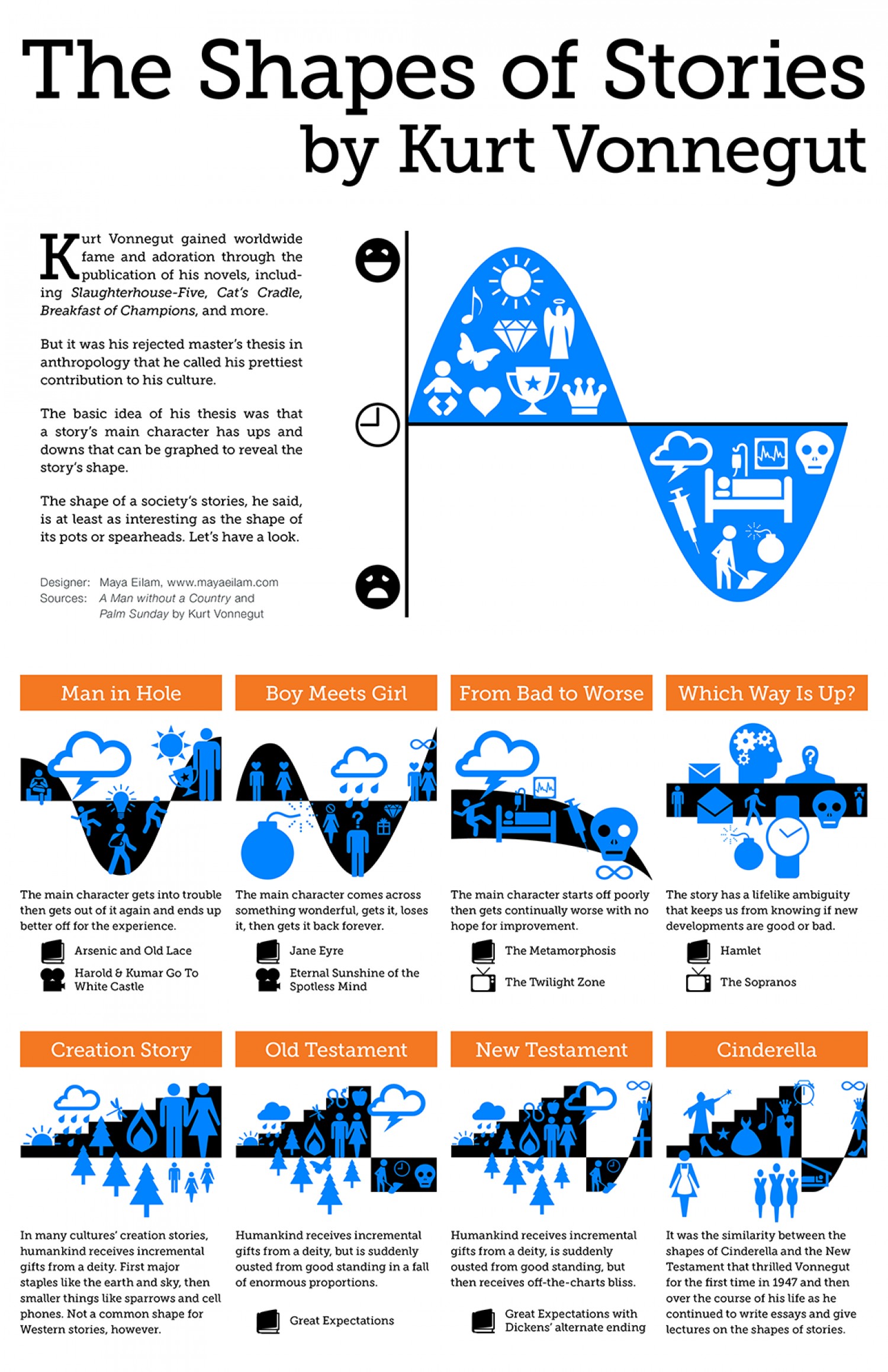
“What has been my prettiest contribution to the culture?” asked Kurt Vonnegut in his autobiography Palm Sunday. His answer? His master’s thesis in anthropology for the University of Chicago, “which was rejected because it was so simple and looked like too much fun.” The elegant simplicity and playfulness of Vonnegut’s idea is exactly its enduring appeal. The idea is so simple, in fact, that Vonnegut sums the whole thing up in one elegant sentence: “The fundamental idea is that stories have shapes which can be drawn on graph paper, and that the shape of a given society’s stories is at least as interesting as the shape of its pots or spearheads.” In 2011, we featured the video below of Vonnegut explaining his theory, “The Shapes of Stories.” We can add to the dry wit of his lesson the picto-infographic by graphic designer Maya Eilam above, which strikingly illustrates, with examples, the various story shapes Vonnegut described in his thesis. (Read a condensed version here.)
The presenter who introduces Vonnegut’s short lecture tells us that “his singular view of the world applies not just to his stories and characters but to some of his theories as well.” This I would affirm. When it comes to puzzling out the import of a story I’ve just read, the last person I usually turn to is the author. But when it comes to what fiction is and does in general, I want to hear it from writers of fiction. Some of the most enduring literary figures are expert writers on writing. Vonnegut, a master communicator, ranks very highly among them. Does it do him a disservice to condense his ideas into what look like high-res, low-readability workplace safety graphics? On the contrary, I think.
Though the design may be a little slick for Vonnegut’s unapologetically industrial approach, he’d have appreciated the slightly corny, slightly macabre boilerplate iconography. His work turns a suspicious eye on overcomplicated posturing and champions unsentimental, Midwestern directness. Vonnegut’s short, trade publication essay, “How to Write With Style,” is as succinct and practical a statement on the subject in existence. One will encounter no more a ruthlessly efficient list than his “Eight Rules for Writing Fiction.” But it’s in his “Shapes of Stories” theory that I find the most insight into what fiction does, in brilliantly simple and funny ways that anyone can appreciate.
Related Content:
The Shape of A Story: Writing Tips from Kurt Vonnegut
Kurt Vonnegut: Where Do I Get My Ideas From? My Disgust with Civilization
Kurt Vonnegut’s Eight Tips on How to Write a Good Short Story
Kurt Vonnegut Reads from Slaughterhouse-Five
Josh Jones is a writer and musician based in Durham, NC. Follow him at @jdmagness


If you graph any trend that allows only 1 inflection point, it will either be monotonic up or down, or it will change direction in the middle. That’s 4 possibilities.
Add a second inflection point to allow for an Aristotelian 3‑act structure, and now you go from 4 to 8 possibilities. The math is really pretty simple.…
But the whole notion is operationally useless. Similar graphs can be applied to any scalar quantity over time, and categorizing very complex things like art or literature according to the shapes of the trend line of a single scalar is not going to be very useful to anyone.
https://en.wikipedia.org/wiki/Monomyth
Kurt Vonnegut is one of the strangest writers of all time. I’m not sure whether to call Slaughterhouse 5 an idiotic rambling of an.ingenious display of nuance. That in and of itself is hard to pull off.
Thank you for acknowledging my infographic! I think “slightly corny, slightly macabre” is a wonderful way to put it.
The poor quality of writing in this article is and amazing and accidentally hilarious. You’ve taken irony to a new level.
Rosewater, you don’t even have correct writing in your own post so you shouldn’t be criticizing this writing when it really isn’t that bad.
Very insightful article on a truly landmark writer who is apparently STILL being assaulted by ignorant naysayers. In fact, the insane level of vitriol spewed here in the comments section is indicative of nothing more than ignorance and jealousy. None of you (Miramon, Jace X Anders, Rosewater) will EVER produce anything that even comes close to the impact that Slaughterhouse-Five has had on the modern world. Insolent, unimaginative and illogical individuals such as yourself have no place in balanced contemporary culture. You are, for all intents and purposes ANTI-INTELLECTUAL and your lack of comprehension here perfectly demonstrates this fact.
I couldn’t agree more with Fah Q … although I would tone down the invective. Many, many readers find Vonnegut inspiring and ingenious. Critics are welcome … but not asked to stay for coffee.
Nice and insightful? Yes! Science? Nope! :)
It’s kind of the teacher from Donnie Darko, who tries to make a “plot” between Fear and Love, trying to explain Aristotle’s Poetics!
Eternal Sunshine… as an example of a story with a happy end? Did you even see the damn movie?!
Vonnegut is a genius, and a humble one at that. For those looking for a taste, but not ready for a full novel, read WELCOME TO THE MONKEY HOUSE, his collection of wonderful short stories.
Thank you for your comment Rosewater, Do you go by Franklin or Barry these days?
Relax. I think he’s being tongue in cheek.
Coq Sandwich gets drippy.